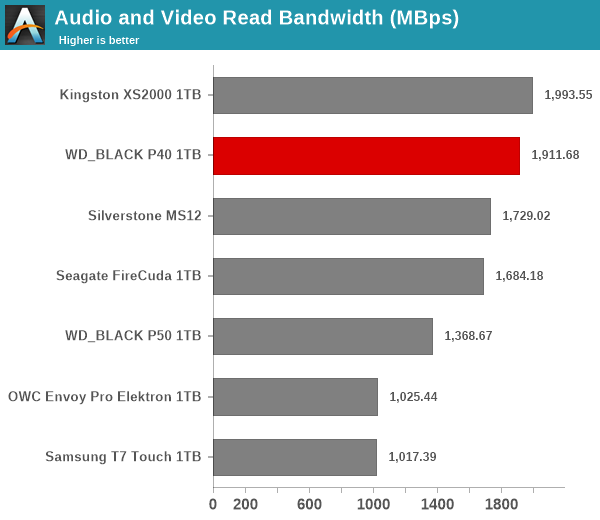WD_BLACK P40 Game Drive USB 3.2 Gen 2x2 Portable SSD Review: Balanced Storage
by Ganesh T S on November 18, 2022 8:00 AM ESTAnandTech DAS Suite - Benchmarking for Performance Consistency
Our testing methodology for storage bridges / direct-attached storage units takes into consideration the usual use-case for such devices. The most common usage scenario is transfer of large amounts of photos and videos to and from the unit. Other usage scenarios include the use of the unit as a download or install location for games and importing files directly from it into a multimedia editing program such as Adobe Photoshop. Some users may even opt to boot an OS off an external storage device.
The AnandTech DAS Suite tackles the first use-case. The evaluation involves processing five different workloads:
- AV: Multimedia content with audio and video files totalling 24.03 GB over 1263 files in 109 sub-folders
- Home: Photos and document files totalling 18.86 GB over 7627 files in 382 sub-folders
- BR: Blu-ray folder structure totalling 23.09 GB over 111 files in 10 sub-folders
- ISOs: OS installation files (ISOs) totalling 28.61 GB over 4 files in one folder
- Disk-to-Disk: Addition of 223.32 GB spread over 171 files in 29 sub-folders to the above four workloads (total of 317.91 GB over 9176 files in 535 sub-folders)
Except for the 'Disk-to-Disk' workload, each data set is first placed in a 29GB RAM drive, and a robocopy command is issue to transfer it to the external storage unit (formatted in exFAT for flash-based units, and NTFS for HDD-based units).
robocopy /NP /MIR /NFL /J /NDL /MT:32 $SRC_PATH $DEST_PATH
Upon completion of the transfer (write test), the contents from the unit are read back into the RAM drive (read test) after a 10 second idling interval. This process is repeated three times for each workload. Read and write speeds, as well as the time taken to complete each pass are recorded. Whenever possible, the temperature of the external storage device is recorded during the idling intervals. Bandwidth for each data set is computed as the average of all three passes.
The 'Disk-to-Disk' workload involves a similar process, but with one iteration only. The data is copied to the external unit from the CPU-attached NVMe drive, and then copied back to the internal drive. It does include more amount of continuous data transfer in a single direction, as data that doesn't fit in the RAM drive is also part of the workload set.

The P40 is in the top three in all of the read workloads. The writes are a different case altogether - the performance is sometimes even worse than 1GBps-class PSSDs such as the Samsung T7 Touch. The write penalty is particularly high for small-sized files. Power users may want to dig deeper to understand the limits of each device. To address this concern, we also instrumented our evaluation scheme for determining performance consistency.
Performance Consistency
Aspects influencing the performance consistency include SLC caching and thermal throttling / firmware caps on access rates to avoid overheating. This is important for power users, as the last thing that they want to see when copying over 100s of GB of data is the transfer rate going down to USB 2.0 speeds.
In addition to tracking the instantaneous read and write speeds of the DAS when processing the AnandTech DAS Suite, the temperature of the drive was also recorded. In earlier reviews, we used to track the temperature all through. However, we have observed that SMART read-outs for the temperature in NVMe SSDs using USB 3.2 Gen 2 bridge chips end up negatively affecting the actual transfer rates. To avoid this problem, we have restricted ourselves to recording the temperature only during the idling intervals. The graphs below present the recorded data.
| AnandTech DAS Suite - Performance Consistency | |
| TOP: | BOTTOM: |
 |
|
 |
|
The first three sets of writes and reads correspond to the AV suite. A small gap (for the transfer of the video suite from the internal SSD to the RAM drive) is followed by three sets for the Home suite. Another small RAM-drive transfer gap is followed by three sets for the Blu-ray folder. This is followed up with the large-sized ISO files set. Finally, we have the single disk-to-disk transfer set. It can be seen that the P40 can indeed go as high as 1800 MBps for the writes, but only for a very short duration. The good news seems to be that it appears to regain the SLC cache relatively quickly. Sustained writes are a problem for the drive, unfortunately. The above graphs show the reason for the PSSD's abysmal showing in the graphs in the previous sub-section. On the thermal front, the temperature is lower than all other 2GBps-class PSSDs except the Seagate Firecuda (which has a completely different performance profile allowing it to cool down rapidly towards the end of the test).










6 Comments
View All Comments
TheCurve - Saturday, November 19, 2022 - link
Loved this review! Direct, no fluff, just honest advice and dataAlB80 - Sunday, November 20, 2022 - link
Support for USB3 10Gbps x2 links are optional for USB4.hMunster - Monday, November 21, 2022 - link
Does OS X finally support TRIM on non-Thunderbolt external SSDs?Techie2 - Monday, December 5, 2022 - link
It's now December and not a single Gen 5 consumer SSD is being offered for sale. That's rather strange considering all the hoopla and claims that these drives would be available in Oct. '22.yifu - Tuesday, December 13, 2022 - link
we need to support anandtech, when innerfidelity went away, there is only commercials reviews. we need anandtech.com, we need some kind of honest authority, otherwise it's just chaos, and shit!!!I have allowed anandtech from ad blocker.
sonsjhon09 - Thursday, December 29, 2022 - link
I appreciate your work